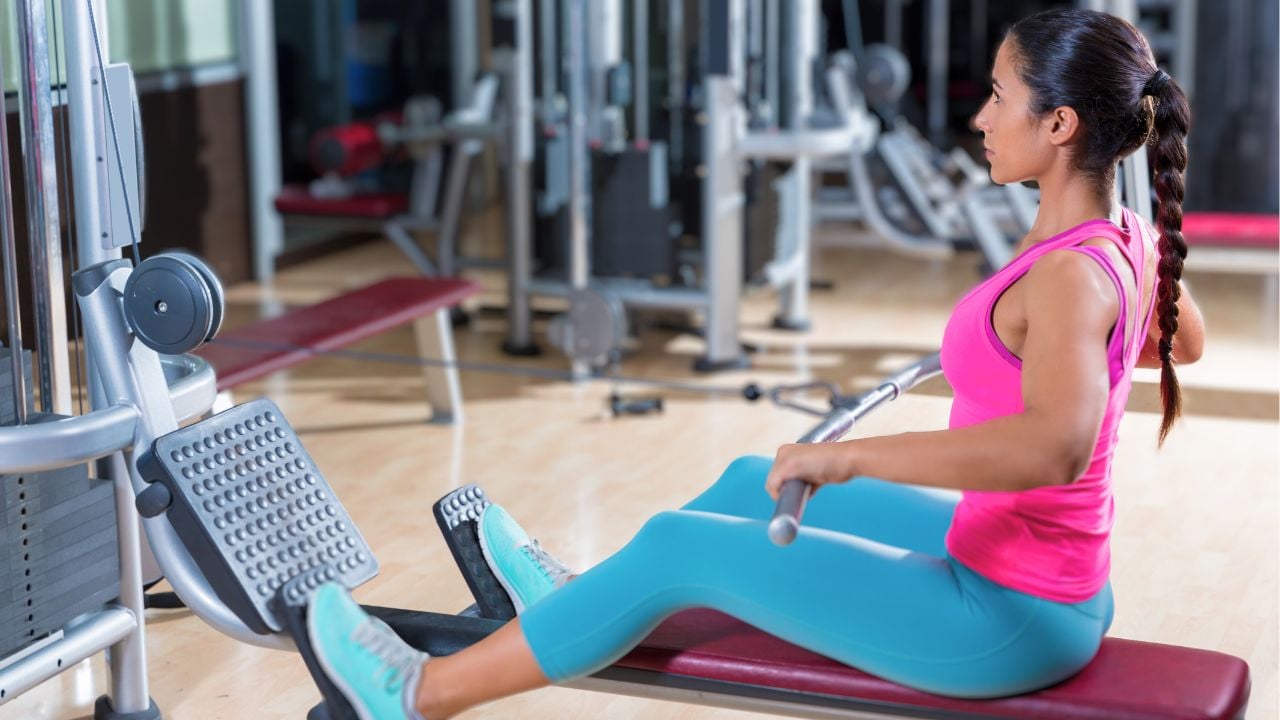The wide-grip cable row is a variation of the traditional cable row exercise that is performed using a significantly wider grip on a straight bar or pull-down bar attachment.
The wider grip naturally encourages greater scapular retraction and targets the outer lats and teres major more effectively. It also heavily recruits the mid-traps, rhomboids, and posterior deltoids.
This seemingly minor adjustment profoundly changes muscle recruitment for unique advantages.
- This row emphasizes the width and flare of the wings more effectively than other rows.
- Allows for a greater range of motion, stretch, and contraction.
- Along with your lats, the wide grip heavily works your middle back muscles, like the rhomboids and trapezius.
- When you do regular rows, your biceps work a lot. However, when you use a wider grip, your back muscles are more involved.
- It breaks up the monotony of traditional back exercises, adding a diverse challenge that stimulates new muscle growth.

Wide Grip Cable Row Muscles Worked
The wide grip seated cable row is a compound exercise that works many muscles simultaneously.
Primary Muscles:
- Latissimus Dorsi (Lats)
- Trapezius (Middle and Lower)
- Rhomboids
- Posterior Deltoids (Rear Delt)
Secondary Muscles:
- Biceps Brachii
- Brachialis
- Forearm
- Core (stabilization)

Want to take your gains to the next level? Discover your daily calorie needs with our free TDEE calculator.
How to Do The Cable Wide Grip Row
- Attach a wide grip bar (e.g., a lat pulldown bar or a specific wide row bar) to a seated cable row machine.
- Sit on the bench, place your feet firmly on the foot-pads with a slight knee bend.
- Maintain an upright torso with a natural arch in your lower back. Avoid rounding.
- Grasp the bar with an overhand (pronated) grip wider than shoulder width. How wide? Experiment, but a good starting point is where your forearms are roughly perpendicular to the bar when your elbows are at 90 degrees by your sides.
- Extend your arms fully, allowing your shoulder blades to protract (stretch forward) – this pre-stretches the lats and rhomboids.
- Your torso should be upright, or leaning slightly back (no more than 10 degrees).
- Pull the bar towards the lower part of your chest, just above your abdomen, and ensure your elbows remain wide and flared out. Focus on pulling with your back muscles, not your arms.
- Pause at the top of the movement, intensely squeezing your back muscles.
- Slowly return the bar to the starting position by extending your arms.
- Do 8 to 12 repetitions for each set and 2 to 4 sets.
Tips and Form
- I see so many people start sloppy here. If your foundation is weak, the entire movement will be compromised.
- Before you even start your set, close your eyes and visualize perfect reps. See your back muscles contracting, feel the squeeze.
- Actively pull your shoulders down. If they start shrugging up, your upper traps are taking over, and that’s not the primary goal here.
- Don’t cheat yourself on range of motion. Get that good stretch forward (scapular protraction) and that powerful squeeze back (scapular retraction).
- Maintain a smooth and controlled tempo throughout the movement. Do not swing your torso back and forth.

To Stay Motivated: 150+ Gym Workout Motivational Quotes To Stay Fit
References
- Saeterbakken A, Andersen V, Brudeseth A, Lund H, Fimland MS. The Effect of Performing Bi- and Unilateral Row Exercises on Core Muscle Activation. Int J Sports Med. 2015 Nov;36(11):900-5. doi: 10.1055/s-0034-1398646. Epub 2015 Jul 2. PMID: 26134664.
- Ronai, Peter M.S., FACSM, ACSM-RCEP, ACSM-CEP, ACSM-EP, EIM III, CSCS. Do It Right: The Seated Cable Row Exercise. ACSM’s Health & Fitness Journal 23(4):p 32-37, 7/8 2019.

Manish is a NASM-certified fitness and nutrition coach with over 10 years of experience in weight lifting and fat loss fitness coaching. He specializes in gym-based training and has a lot of knowledge about exercise, lifting technique, biomechanics, and more.
Through “Fit Life Regime,” he generously shares the insights he’s gained over a decade in the field. His goal is to equip others with the knowledge to start their own fitness journey.
